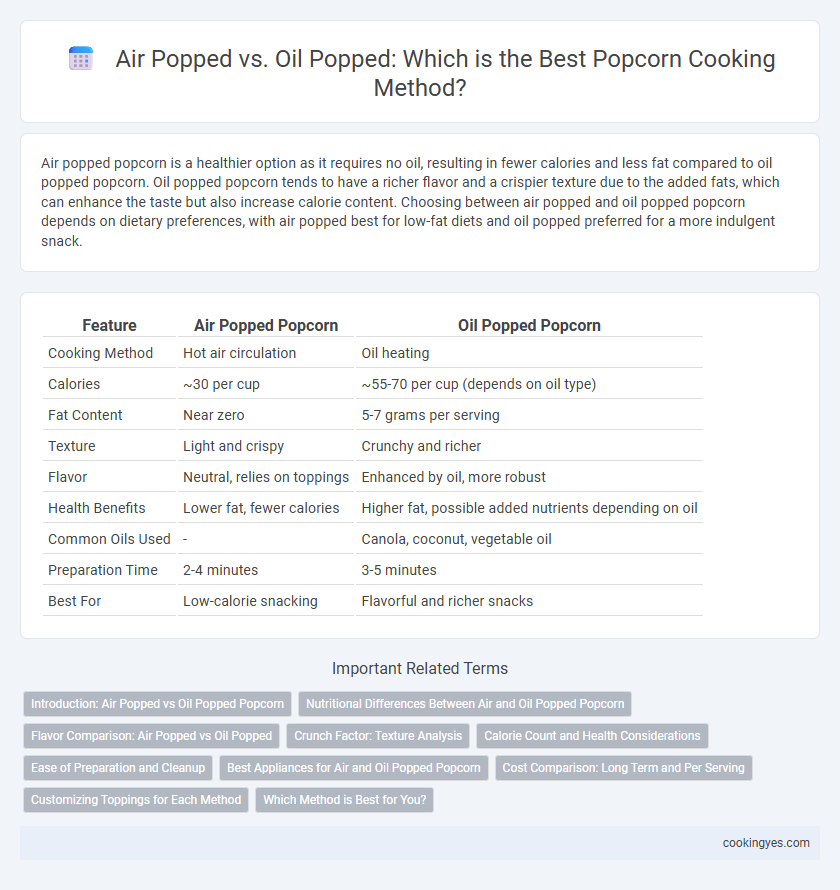Air popped popcorn is a healthier option as it requires no oil, resulting in fewer calories and less fat compared to oil popped popcorn. Oil popped popcorn tends to have a richer flavor and a crispier texture due to the added fats, which can enhance the taste but also increase calorie content. Choosing between air popped and oil popped popcorn depends on dietary preferences, with air popped best for low-fat diets and oil popped preferred for a more indulgent snack.
Table of Comparison
| Feature | Air Popped Popcorn | Oil Popped Popcorn |
|---|---|---|
| Cooking Method | Hot air circulation | Oil heating |
| Calories | ~30 per cup | ~55-70 per cup (depends on oil type) |
| Fat Content | Near zero | 5-7 grams per serving |
| Texture | Light and crispy | Crunchy and richer |
| Flavor | Neutral, relies on toppings | Enhanced by oil, more robust |
| Health Benefits | Lower fat, fewer calories | Higher fat, possible added nutrients depending on oil |
| Common Oils Used | - | Canola, coconut, vegetable oil |
| Preparation Time | 2-4 minutes | 3-5 minutes |
| Best For | Low-calorie snacking | Flavorful and richer snacks |
Introduction: Air Popped vs Oil Popped Popcorn
Air popped popcorn is made by forcing hot air through kernels, resulting in a low-calorie snack free from added fats, making it ideal for health-conscious individuals. Oil popped popcorn involves cooking kernels in oil, which enhances flavor and produces a richer texture but increases calorie content. Choosing between air popped and oil popped methods depends on dietary preferences, desired taste, and nutritional goals.
Nutritional Differences Between Air and Oil Popped Popcorn
Air popped popcorn contains fewer calories and less fat compared to oil popped popcorn, making it a healthier option for weight management. Oil popped popcorn has added fat content due to the cooking oil, which increases its calorie density and can contribute to higher saturated fat intake if unhealthy oils are used. Both methods provide dietary fiber and antioxidants, but air popping preserves these benefits with minimal added ingredients.
Flavor Comparison: Air Popped vs Oil Popped
Air popped popcorn offers a lighter, more natural flavor, highlighting the corn's inherent taste without added oils or fats. Oil popped popcorn provides a richer, buttery flavor due to the oil's infusion, enhancing the overall savory experience. The choice between air popped and oil popped popcorn largely depends on flavor preference and desired texture, with air popped being crisp and clean, while oil popped delivers a more indulgent, robust taste.
Crunch Factor: Texture Analysis
Air-popped popcorn delivers a light, crisp crunch due to the absence of added oils, which allows the kernels to expand fully and maintain their natural texture. Oil-popped popcorn has a richer, slightly denser crunch as the oil coating enhances flavor and creates a firmer surface on each kernel. Texture analysis shows air-popped popcorn excels in a dry, brittle crispness, while oil-popped varieties offer a more substantial, satisfying crunch with a subtle oily smoothness.
Calorie Count and Health Considerations
Air-popped popcorn contains approximately 30 calories per cup and is free from added fats, making it a lower-calorie, heart-healthy snack option rich in fiber and antioxidants. Oil-popped popcorn typically has around 55 calories per cup, with added fats that increase the calorie count and may impact cholesterol levels depending on the type of oil used. Choosing air-popped popcorn supports weight management and cardiovascular health by minimizing fat intake while still providing whole-grain nutrition.
Ease of Preparation and Cleanup
Air-popped popcorn offers a quicker preparation time and minimal cleanup due to the absence of oil residue, making it convenient for busy individuals. Oil-popped popcorn requires additional steps such as heating oil and cleaning greasy cookware, which can prolong the process and increase cleanup effort. Choosing air popping enhances ease of preparation and cleanup by eliminating the need for oil management and reducing post-cooking mess.
Best Appliances for Air and Oil Popped Popcorn
Air-popped popcorn requires appliances like electric hot air poppers that use rapid hot air circulation, producing a healthier, low-calorie snack without added fats. Oil-popped popcorn benefits from stovetop poppers or electric popcorn makers with built-in oil reservoirs, enhancing flavor and texture through even heat distribution and controlled popping temperature. Brands such as Presto and Cuisinart offer reliable models optimized for oil popping, while West Bend and Great Northern Popcorn specialize in efficient air poppers.
Cost Comparison: Long Term and Per Serving
Air-popped popcorn requires no oil, significantly reducing both upfront and ongoing costs compared to oil-popped popcorn, which involves expenses for cooking oil purchase and replacement. Over time, air popping proves more economical, with the per-serving cost often under $0.05, while oil-popped popcorn can exceed $0.10 per serving due to oil consumption. Energy usage is also lower for air poppers, contributing to cost savings when comparing long-term popcorn preparation methods.
Customizing Toppings for Each Method
Air-popped popcorn offers a light, crispy base that allows toppings like nutritional yeast, smoked paprika, or fine sea salt to adhere well without added fats, enhancing flavor while maintaining low calories. Oil-popped popcorn retains a richer texture that helps butter, cheese powders, and savory spices evenly coat the kernels for a more indulgent taste experience. Customizing toppings based on the cooking method maximizes both flavor and texture, catering to preferences for health-conscious or gourmet popcorn snacks.
Which Method is Best for You?
Air-popped popcorn contains fewer calories and less fat, making it an ideal choice for those seeking a healthy snack with a light, crunchy texture. Oil-popped popcorn delivers a richer flavor and a crispier bite, favored by individuals who prioritize taste and a more satisfying mouthfeel. Choosing the best method depends on personal dietary goals and flavor preferences, with air popping best for calorie-conscious consumers and oil popping preferred by those who enjoy indulgence.
Air Popped vs Oil Popped for Popcorn Cooking Method Infographic

 cookingyes.com
cookingyes.com